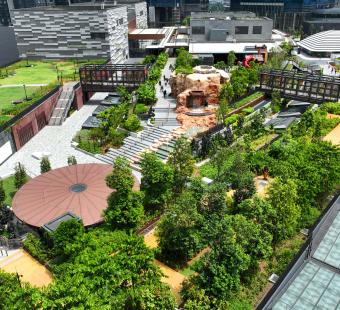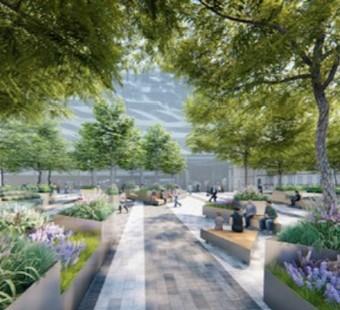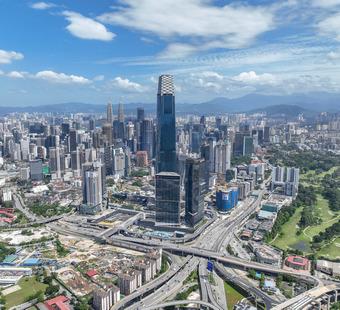As Malaysia’s first international financial centre, the Tun Razak Exchange (TRX) has a future-focused agenda for economic growth and stability.
“We cannot discuss a secure future in any meaningful way without having sustainability at its core,” says Dato’ Haji Azmar Talib, Chief Executive Officer of TRX City Sdn Bhd.
International benchmarks
The Malaysian capital’s new CBD has been benchmarked against world-leading CBDs, such as IFC Hong Kong and London’s Canary Wharf. The sustainability standards built into the TRX masterplan are best in class in Southeast Asia, and among the finest internationally.
Comprehensive plans for the whole district have been recognised by both local and international sustainability awards. TRX is the first in Southeast Asia to achieve both the US-based Leadership in Energy and Environmental Design (LEED) Neighborhood Development at a Gold Pre-Certified Plan level as well as the Green Building Index (GBI) Township award at Platinum provisional certification. The holistic district-wide design is complemented by similarly high standards at the individual plot level.
“Every development parcel in TRX commits to site-wide sustainability standards established by TRX, including building design, building systems and materials, as well as energy and resource usage,” says Dato’ Azmar, who explains that plot developers are contractually bound to achieve certain LEED certification ratings and encouraged to also go for GBI certification.
TRX will then oversee the implementation of sustainability assessments of every plot within the whole district.
Efficient resource use
These aspiring designs, already being implemented throughout TRX, aim to cut resource use significantly.
“Our goal is to achieve at least 50 percent reductions in water usage and at least 30 percent less energy use, as well as to cut carbon emissions by at least 40 percent and approximately 70 percent reduction of waste to landfill,” says Dato Azmar.
District-wide electricity is supplied using a system featuring Tenaga Nasional Berhad’s (TNB) most innovative, top-notch design, which includes Malaysia’s first Dedicated Utility Tunnel (DUT). TRX will also feature Southeast Asia’s first fully integrated commercial water reclaim programme, centred around its own dedicated wastewater management plant, run by multinational corporation, Veolia, a global leader in resource management.
The loop system works to collect rainwater and all wastewater generated throughout TRX, then recycle it at the plant, before returning the water back to the district for non-potable use, such as irrigation, cooling and toilet flushing.
The technologies employed at the recycling plant have been uniquely assembled for TRX. The result will be a reduction of over 50 percent in total potable water demand compared to a typical development. This exceeds the international best practice standard of 40 percent reduction.
Using the latest smart city technologies and digital backbone will also play a significant role in achieving resource efficiencies; monitoring will be continuous alongside swift and targeted controls that minimise wastage throughout the district. For instance, water leakages will be detected immediately and air conditioning levels can be automatically adjusted based on how many people are in a building.
Tailored features
Individual plot managers have also brought their own sustainable practices to bear, hitting the stipulated sustainability standards by using different measures and technologies that best suit their own buildings.
Exchange 106 and Menara Prudential have also ameliorated the urban heat island effect with techniques such as open-grid pavement systems and heat-reducing materials used on non-roof hardscapes, including paving materials with solar reflection index. Façades also play an important role in heat reduction; the crown of Exchange 106 is double glazed with a vacuum in the middle which keeps heat out and cool in. There is also a UV coating added which reduces heat by 40 percent. At Affin Bank and HSBC, the heat is lessened with a vegetated green roof that also incorporates high-SRI materials, which are also used for paving.
All four towers have a comprehensive Building Management System (BMS) in place that controls and maximises efficiency for resource use, including electricity, water and air-conditioning.
Recycling will also be a prominent feature at all plots. Provision of storage and collection of recyclables will be set up at Affin Bank, HSBC and the residential towers, which are also recycling at least 20 percent of total non-hazardous construction waste. Recycling of construction materials was also done at Exchange 106, and is currently being carried out at the lifestyle quarter, known as The Exchange TRX, which includes the retail mall. Rainwater harvesting and recycling is also in place at Exchange 106, Affin Bank, HSBC and throughout The Exchange TRX, one of the largest single plots at the CBD.
The Exchange TRX, a joint venture between international real estate giant, Lendlease, and TRX City Sdn Bhd, boasts some of the most impressive best practice sustainability measures, from efficient lighting and equipment, low-VOC materials and finishes which reduce pollution, and ambitious targets to reduce operational waste. In fact, The Exchange TRX will adopt zero waste principles - reuse, reduce, recycle - to move towards achieving carbon-neutral operations. There is even a Climate Change Adaptation policy in the works to futureproof against flooding, drought, heatwaves and haze.
Pedestrianisation and public transport
At the heart of The Exchange TRX, and the entire district as a whole, is an oasis of green; a large public park that will be a bulwark against pollution and a boon for urban health. The biodiversity found there will be unbeatable, with over 180,000 plantings that showcase 170 local plant species.
“TRX’s 10-acre city park will be a gift for Kuala Lumpur, a place of recreation, rest and respite, for workers and visitors alike,” says Dato’ Azmar, as he describes the greenery permeating out from the park to plazas, walkways and landscaped spots throughout the district, extending all the way to the shopping belt of Bukit Bintang and Pavilion.
In line with its design as a financial district in a park, up to a third of the Tun Razak Exchange will consist of a green public realm that is open to all. With pedestrianisation a key focus, the public realm will ensure that walking is a comfortable and pleasant experience. Combined with the dedicated MRT station - the only interchange station within the city - travelling within, to and from TRX can be a more sustainable activity, without the need for cars. This will cut down pollution and carbon emissions, and encourage a healthier physical and mental lifestyle, with exercise and connection to nature a regular and pleasurable occurrence in daily life.
Throughout the TRX public realm, thousands of plants, trees and shrubs species - 90 percent of them native or naturalised to Malaysia - have been curated to encourage a healthy dependency that nurtures the habitat and nutritional needs of urban wildlife, such as birds, squirrels, bees and insects. The result is that flora and fauna in TRX will also thrive alongside their human neighbours.
---




